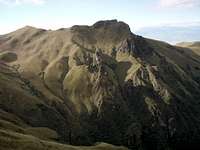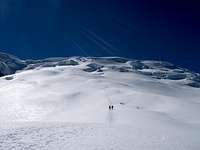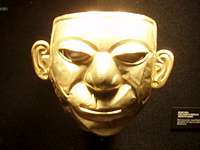Background
Plans to climb Kilimanjaro this summer fell through so a ‘Plan B’ trip was needed. We decided on South America; since we only had two weeks Ecuador seemed like the best option for getting some international climbing done. There was plenty of initial interest but once the time arrived to purchase the plane tickets it was down to a team of three with Axe and Bill562 joining me. I had briefly met Bill562 several years ago in Colorado but we had never climbed together.
Initial plans were to attempt Iliniza Norte, Cotopaxi, Chimborazo and maybe Iliniza Sur along with a few smaller peaks around Quito for acclimatization. Rest and travel days were planned between the larger mountains. From my research I figured there were two ways to climb in Ecuador. One was to base out of Quito for the trip and travel back and forth from the mountain de jour. The other was to see more of the country and stay in nearby towns or cities either before or after a climb. We planned based on the latter option.
There are two normal climbing seasons in Ecuador. The primary season is November to January the other is June to August, each season has its advantages and disadvantages. Locals told us to avoid visiting in April and May as this is a very rainy period which limits what you can see or do anywhere in Ecuador. We wanted to climb in July due to schedules and jobs so we expected to have weather issues to work around since summer climbs can be very windy.
Quito
![Sierra Nevada]() Sierra Nevada
Sierra NevadaWe stayed at Hotel Sierra Nevada in the Mariscal area of New Town after recommendations from other SP members and several guidebooks. The owner, Freddy Ramirez, is one of the original Ecuadorian guides that trained in France years ago. Freddy provides plenty of services to make your trip to Ecuador memorable. We met with him our first morning which turned my carefully planned schedule inside out. With two of us coming from sea level more acclimatizing was recommended so we added a day around Quito to climb another trekking peak. We arranged transport for the days we needed it from Freddy, at $70-90 a day including the driver and fuel, which was easier than dealing with the bus system with all the equipment we brought.
The first day in Quito at 9200 ft. should be an easy day. So we spent it walking around and getting a feel for the city, both the Mariscal and Old Town. One of the first stops was in the embassy area where the South American Explorers clubhouse is also located. We had a quick tour by a summer intern of the clubhouse and its resources. With a research library, staff and computers it is a great place to visit. This home away from home does require membership.
![Plaza Grande]() Plaza Grande
Plaza Grande
Old Town, the Spanish colonial heart of Quito, occupied the bulk of the day. Our first tourist act was to wander through the Basilica del Voto Nacional, a more modern gothic style church built in the last 100 years. We continued wandering around the streets and through small markets experiencing the well preserved Old Town. One of the main plazas is the Monastery of San Francisco, construction of which started in 1534. It is currently being repaired so much of the inside was covered in scaffolding. As many tourists pass through here there are plenty of people trying to sell anything from shoe shines to guided tours so stay alert for scams and petty theft.
We experienced a set lunch, or el allmuerzo, at Restaurante Latino down the street from the cathedral for the low cost of $2 USD. As the restaurant was full of locals it was a safe bet for our first meal. Delicious! We then visited the Plaza Grande, the heart of Old Town, where several historic buildings surround the plaza and are either still used by the government or have modern use as shops or restaurants. The Cathedral Primada cathedral is also a museum that houses artwork and tombs of famous Ecuadorians. It is well worth the $1.50 admission fee.
The Mariscal district is full of restaurants. For dinner we tried Mama Clorindas which serves Ecuadorian cuisine (cuy or Guinea pig included) to mostly a foreign clientele. It is well worth the midrange prices for the quantity and quality of its food.
Warm-up climbs
Our first climbing objective was a day hike of Pasochoa. This 13,800 foot mountain is about an hour south of Quito. As this was our first time outside of Quito since our arrival we were constantly looking around at all the mountains surrounding the city—especially the ones we planned to climb later in the trip. It was hard to tell at times the difference between a snowy summit and a white cloud! Beautiful country!
![Final Approach]() Final approach
Final approach
This hike was straightforward. It starts as an old road that ends at an abandoned building. We turned right into a field and then continued towards the summit. After crossing a couple of livestock fences we could see the ridge that leads to the summit. There is a canal along the ridge for water control. The ditch is deep and difficult to cross the farther up the ridge you go. At the last fence a path leads into a small patch of trees where the canal ends. The trail uphill of the canal is in better shape than the other side of the canal. Once up the ridge you realize that the outcrop is a false summit. Follow the trail around the left of the next outcrop which is also a false summit. The true summit is directly in front of you and has a well defined trail between the two points. A short climb through some jungle like trees gives way to the summit.
![Padre Encantado]() Guagua from Rucu
Guagua from Rucu
The climbing objective the next day was Rucu Pichincha which rises northwest behind Quito. A quick taxi ride to the TeleferiQo (gondola) and then a $4 ride will takes you to approximately 13,000 feet. From the tourist buildings it is a two hour plus hike to the top of the 15,600 foot peak with the last 100 vertical feet offering some Class II rock climbing. The top of Rucu has a great view of Quito and Guagua Pichincha. Depending on the cloud cover you might see the major volcanoes surrounding the valley.
Another restaurant in the Marsical is La Belle Italia near Sierra Nevada that has large wood pizza oven that makes great pizza and calzones. A nice café for midday eating it at Amazonas and Foch called Fonfone Café.
Iliniza Norte and Sur
![Norte from the hut]() Norte from the hut.
Norte from the hut.After dropping extra gear off at Hacienda San Jose we were dropped off at the La Virgin (sp) parking lot, the start of our climb to the refuge near the saddle between Norte and Sur. There is a dirt road and multiple trails for 3/4ths of the way. The best trail is the far right side that actually travels along the side of the hill instead of up and over it. Either way all the trails will lead to a gray lateral moraine that angles steeply from right to left with the upper portion ending near the gap between the mountains.
The refuge is small with bunk space for 15 or so. It was the worst refuge we used while in Ecuador. It is slightly dirty with a strong kerosene smell from a leaking stove filling the hut once the door is closed. We shared the hut with three Spaniards who returned from Norte as we arrived. Norte was crusted in snow and ice from a recent storm.
![Sur July 2007]() Sur from Norte slope.
Sur from Norte slope.
The route follows the ridge from the saddle and then crosses to the opposite side to a rather steep climb up the second peak. At 16,800 feet the views are amazing especially of Sur across the old crater. Due to our newness as a team we decided Sur would have to wait for another day.
After packing up and paying ($10) the hut attendant who arrived while we were gone we headed back down the mountain to Hda. San Jose. Rodrigo gave us a map to follow so we could hike back. From the refuge to San Jose took less than 4 hours including breaks. The Hacienda is bed and breakfast only so make sure to take enough food. The breakfast the next morning was worth the price of admission (also $10 per night).
On to Cotopaxi
![Market]() Market
MarketAfter repacking and practicing our rope travel and rescue skills our driver, Edison, showed up on time to take us to the refuge on Cotopaxi. We first stopped in the town of Machachi to buy supplies in the market and at the grocery store. After eating dehydrated food on Iliniza we decided to take fresh food to the huts for the rest of the trip.
At the entrance to the park we paid our park fee of $10 and used Edison, who is also a guide, to get in the park even though we were climbing unguided. We were dropped off at the parking lot where we started the 600 foot 1 hour hike up to the refuge. This hut was much nicer than our previous experience. The ground level included two kitchens and numerous tables and even a pay phone. There is space upstairs for 60 or so climbers in two large rooms. The rooms have large lockers on the walls for gear storage while climbing. We used one locker for the three of us. Locks are not provided so take one with you.
![Cotopaxi from Parking lot]() View of inital route on right side
View of inital route on right side
If you have the time it would be best to scout the route to the glacier as conditions have changed which make many guidebooks inaccurate regarding the start of the climb. The trail starts past the bathrooms and gradually goes up in elevation before dropping into a small valley where the glacier tongue ends. This is where you need to rope up and put on crampons. Climb up the tongue and stay to the right side to gain access around a small valley of seracs. From here the trail went straight up for few hours before gaining the upper shoulder of the mountain near the band. We had terrible weather (wind, snow, clouds and then whiteout conditions) so visibility was limited to 150 feet or less. The upper mountain had a decent boot track in most places but wands were helpful. We heard that there is a crater on the top of Cotopaxi but as we could not see it we had to buy some postcards of it instead.
Rest and Realization
After Cotopaxi we went to Banos to rest up from the activity of the previous week. We also realized that while we succeeded on Cotopaxi that we weren’t in the shape needed to safely take on Chimborazo in a couple of days. We decided on a consolation prize—to attempt Cayambe later in the week.
![Waterfall, Banos]() At the hotsprings
At the hotsprings
Banos is a great low elevation (6200 ft) place to rest and recovery. Located at the base of an active volcano, Tungurahua, it is in a transition zone between the highlands and the Amazon jungle. The town thrives on activity and tourists. You can find guides for all sorts of adventures—climbing, horseback riding, mountain biking and rafting to name just a few.
![Posada]() Posada del Arte
Posada del Arte
The town is named for the hot mineral springs there. On the east side of town there is a 200+ foot waterfall that cascades off the cliff and is incorporated into the municipal hot springs. Rates range from $0.80 – 2 dollars depending on your age and time of day. The hottest pool is 118 degrees!
We stayed at the midrange Hostal Posada del Arte only a block away from the hot springs but more importantly several blocks from the noisy main street at the center of town. The food at their restaurant was as excellent as the accommodations of the hotel. What was really nice about this hostal was excellent artwork on the walls. All the art is by Ecuadorian artists and is for sale. Arrangements can be made to ship purchases worldwide.
An excellent day trip out of Banos is 20 minutes east towards the Amazon. A series of waterfalls there are billed as the nicest waterfalls in Ecuador. A noticeable increase in jungle vegetation and birdlife can also be seen at this lower elevation.
Cayambe
We traveled back to Quito from Banos before heading to Cayambe the following day. At just under 19,000 feet Cayambe is often used as the first mountain during a trip to practice snow skills and to get used to the altitude. The road goes right to the hut at 15,200 feet. At least it does when the snow is melted out. We had to park and then pack all our gear for a 20 minute hike to the hut, so much for a front row parking place.
![Lower Glacier]() Start of the glacier.
Start of the glacier.
The hut is even nicer than the Cotopaxi hut as the bathrooms are in the ground level with flushing toilets and running water in the sinks. The 20+ climbers in the hut were there for snow skills before climbing the following nights so we were the only group going out.
![Upper Glacier]() Upper mountain
Upper mountain
We noticed the many days at altitude allowed us to get more rest than we had earlier in the trip before our midnight wake up. We were geared up and ready to go by 1 am. The climb is straightforward, more so in my opinion than Cotopaxi. The hill next to the hut is snow and rock which you climb to the top of in about an hour. At the top there is a valley to the left with a ridge to the right. Stay on this ridge as it leads to the glacier. Too far to the right is a cliff into the main glacier valley. At the top of the ridge is the true glacier so rope up. Continue up the slope until the summit is to your right which is a good place to put a few wands. Turn almost 90 degrees and work through the glacier obstacles, crevasses, seracs, bergshrunds, etc. towards the summit. A short 60 degree ice climb got us to the upper slope and the summit access. It was cloudless at our altitude so the views were beautiful of the surrounding country and mountains. We could almost see the crater on Cotopaxi…
Things to do in Quito when your tired
![Mask]() All that glitters...
All that glitters...Our final days were busy. We visited the Museum which was excellent. It started with an overview of all the known cultures of Ecuador with artifacts (mostly ceramic) representing each starting back thousands of years ago and ending with the most well known, the Inca. An exhibit of religious art moved into the history of the republic and the fight for independence. The final floors housed republic era and contemporary art from Ecuadorian artists. If you have extra time in Quito this museum is well worth a visit.
![Otovalo]() Otovalo
Otovalo
One can argue that a visit to Ecuador in not complete without a visit to the Otovalo market of which Saturday is the primary day. Most vendors in Ecuador will quote a price that is only a starting point to negotiate from there. Use a price about half of the original quote to start negotiations on your end. After a couple of counter proposals both parties should find a price that is agreeable.
A couple dozen blocks were blocked off with booths of goods for sell. The sea of colors and items was amazing along with all the smells of food from the food booths and restaurants. Prices were cheaper and easier to negotiate as the day went on as most visit in the morning leaving the afternoon less crowded. You can find items from all over the country allowing you to complete your souvenir shopping in one day.
Wrap up
Ecuador is an amazing country. The people are very friendly and there is plenty to do when you aren’t climbing; far more than we could fit into only 15 days.
A few things stand out as I think back on the trip.
•Schedules can and will change. Be flexible and open to the new opportunities.
•Cash is preferred over credit cards in Ecuador as the process fees are very steep 10-18%.
•Make sure you have the PIN to your credit card.
•There are plenty of cheap laundry services so you can limit the amount of cloths you take.
•Temperatures in July vary. Take a pair of shorts just in case.
•Sanduche (sugarcane alcohol) tastes great and is very strong.
•Only visit busy restaurants. Never be the only one eating in the restaurant even if it is in the guidebook.
•Take small bills with you to make shopping easy—5, 10, 20s are much better than 50 or 100s. Use the big bills for bigger purchases—hotels, guides, drivers.
•Get out of Quito and stay in other towns and cities to really experience Ecuador.
•Arrival times and departures are only guides and not absolutes. Be flexible.
•Another nice place to stay in Quito is Hostal Zentrum at Jose Murillo y 9 de Octobre. Hostalzentrum@hotmail.com.
•The British pub La Reina Victoria is worth a visit. The fish and chips are average but the shepards pie is good.























Comments
Post a Comment